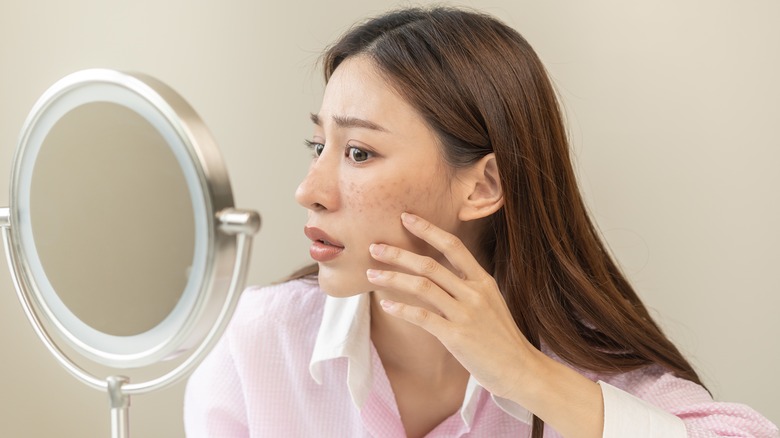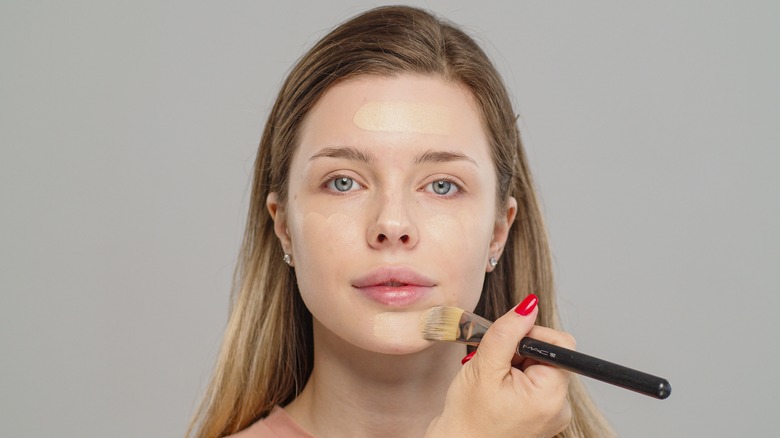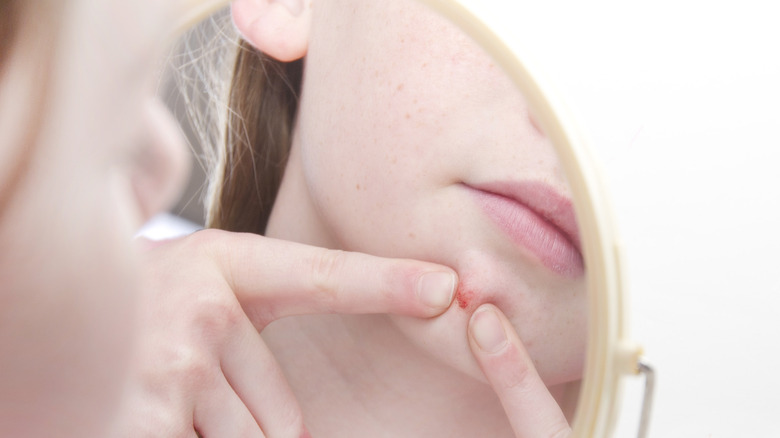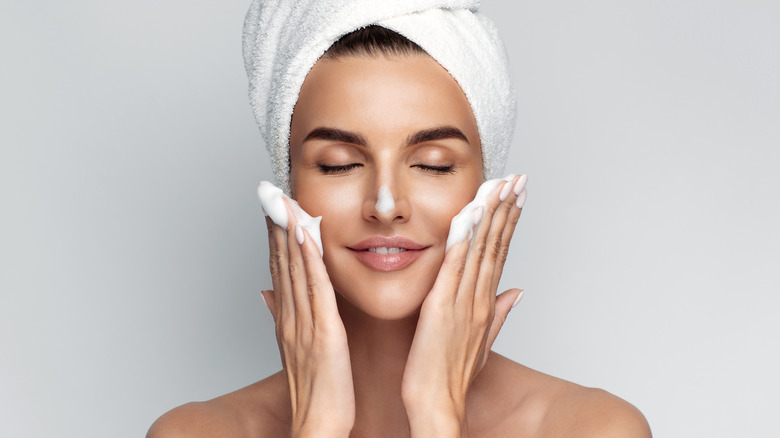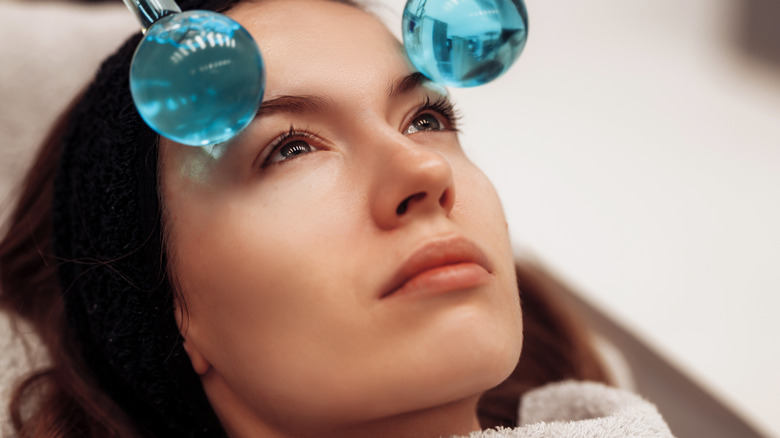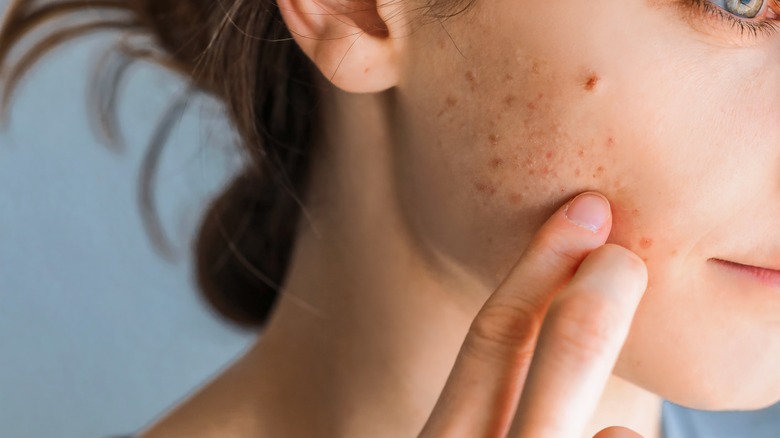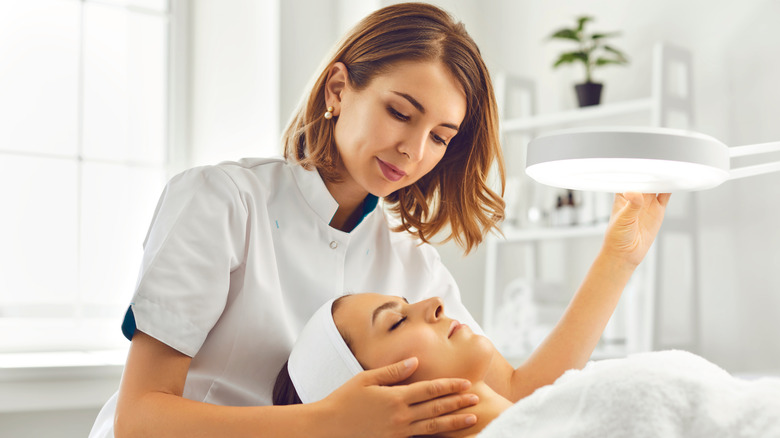Tips For Remedying Post-Facial Scabs
After an appointment with an esthetician, you should step out feeling glowy, fresh, and ready to take on the world. Unfortunately, however, that isn't always the case. Aggressive extractions, powerful products, and rough exfoliation might leave you facing more damage than good in the form of scabs and irritation. According to a study published in Frontiers in Medicine, around 60% of people report having sensitive skin, yet many estheticians use harsh methods that don't work on everyone's skin in an effort to guarantee quick results.
Before you panic and lock yourself in your house until you heal properly, there are some steps you can take to speed up your skin's recovery and reduce the chances of scarring and dark marks from scabs. Of course, the most important ingredient in the healing process is a bit of patience, but while you're waiting, there are a few things to keep in mind if you want to guarantee a stress-free recovery.
Skip the makeup
When it comes to blemishes on the face, our first instinct is often to apply a bit of concealer or foundation to help cover up. When you're working with healing wounds, however, this isn't the best option. Makeup tends to highlight the texture of blemishes even when applied by the most skilled of artists, and brushes can carry bacteria and germs that might worsen the problem in the form of further breakouts and infections, per NewGel Plus. Instead, embrace your natural skin for a little while to allow your body to work its magic and fully heal.
If you still feel a bit naked without your daily beat, eye makeup and brow products are still on the table, but skipping the base in favor of gentle skincare products will allow you to get back to your regular makeup routine more quickly. The healing process can take anywhere from a few days to a few weeks, so just keep an eye on your skin to determine when to jump back in.
Don't pick
We know — this is the hardest part. The temptation to pick off scabs and hopefully reveal a smooth, blemish-free area is strong, but nine times out of 10, you'll just worsen the problem. A scab is your body's way of protecting a wound while it's rebuilding the damaged skin underneath. Picking it off can worsen your chance of scarring, expose the spot to infections, and extend the healing time you'll have to face.
Instead, wait until your scab falls off naturally. Your body has an amazing ability to heal itself, so trust that it knows when the process is over. After your skin is fully healed, the scab will usually jump ship on its own, but if it needs a little help, gently washing your face or taking a shower can give it an extra push. If that still doesn't cause it to fall off, it's not ready and you should wait a bit longer.
Avoid exfoliation
When it comes to the healing process, everything you're putting on your skin should be gentle. Exfoliation can help smooth your face and remove dead skin cells, but you can't scrub away acne and scabs. After an aggressive facial, the focus should be on rebuilding your skin's moisture barrier and giving it the chance to return to equilibrium.
Exfoliating masks, scrubbers, and face washes with included physical exfoliants like beads and grainy ingredients are off the table. Instead, stick to gentle face washes that don't leave your face feeling tight or dry. According to Healthline, antibacterial ingredients like benzoyl peroxide and salicylic acid can help keep your skin clean, and hydrating inclusions like hyaluronic acid can work to rebuild your skin's natural barrier and speed up the healing process. Gently wash with your hands, then pat dry with a soft towel — just stay away from any rough scrubbing that could peel scabs or cause further issues.
Keep it cool
After a bad facial, your skin is likely feeling swollen and irritated. To help combat some of that redness without applying makeup, consider using cooling serums, masks, and tools. Warmth helps encourage blood flow to an area, helping to open up pores and allow your skin to better absorb products, but cold does the opposite, reducing inflammation and giving your skin some much needed relief.
Aloe is a perfect ingredient for this (per Medical News Today). While its main use is soothing sunburns, it is great for calming skin and keeping it moisturized at the same time. Placing your products in the fridge can be a major help, too. Grab a few hydrating face masks and keep them in your refrigerator for moments your skin is feeling overwhelmed, or store your favorite serums cold to give you a soothing burst during your morning routine. Plain ice wrapped in a towel works, too — just make sure you do this in moderation, as using cold therapy on your face too frequently can actually dry out your skin over time.
Target inflammation
Your skin will naturally heal itself over time, so sticking to a simple, hydrating skincare routine will do the trick regardless, but if you want to speed up the process, look for products that target inflammation specifically. If you're dealing with redness, itchiness, and rashes, grab some cortisone cream and apply once a day. According to the National Health Service, this product helps to reduce your body's immune response, a common cause of swelling and itching.
Other products that can be helpful include soothing serums and spot treatments that are designed to seal off and protect active breakouts. Hydrocolloid patches can do the trick, too, especially if you frequently touch your skin and need a physical reminder to not pick. As long as they don't contain any additional ingredients, they function just like regular bandages, protecting a wound from outside contaminants without sticking to the healing area underneath (per Healthline).
Go to the dermatologist or another esthetician
If it's been a while and you're not seeing much progress, it might be best to go see a professional. Everyday products can help move the process along, but skincare specialists have a wealth of treatments and knowledge at their disposal that can quickly nip the problem in the bud. Just make sure you're going to someone who's knowledgeable and has the proper qualifications — the last thing you need is more irritation on top of already damaged skin.
For more serious issues like an allergic reaction or infection, a dermatologist is your best option. Going to see a doctor might seem like overkill, but proper diagnosis and higher-strength prescription topical treatments are sometimes the only way to put an end to your skincare woes. Either way, just know these problems won't last forever. Our bodies have an amazing ability to rebuild, so with a little patience, you'll be back to clear skin in no time.
